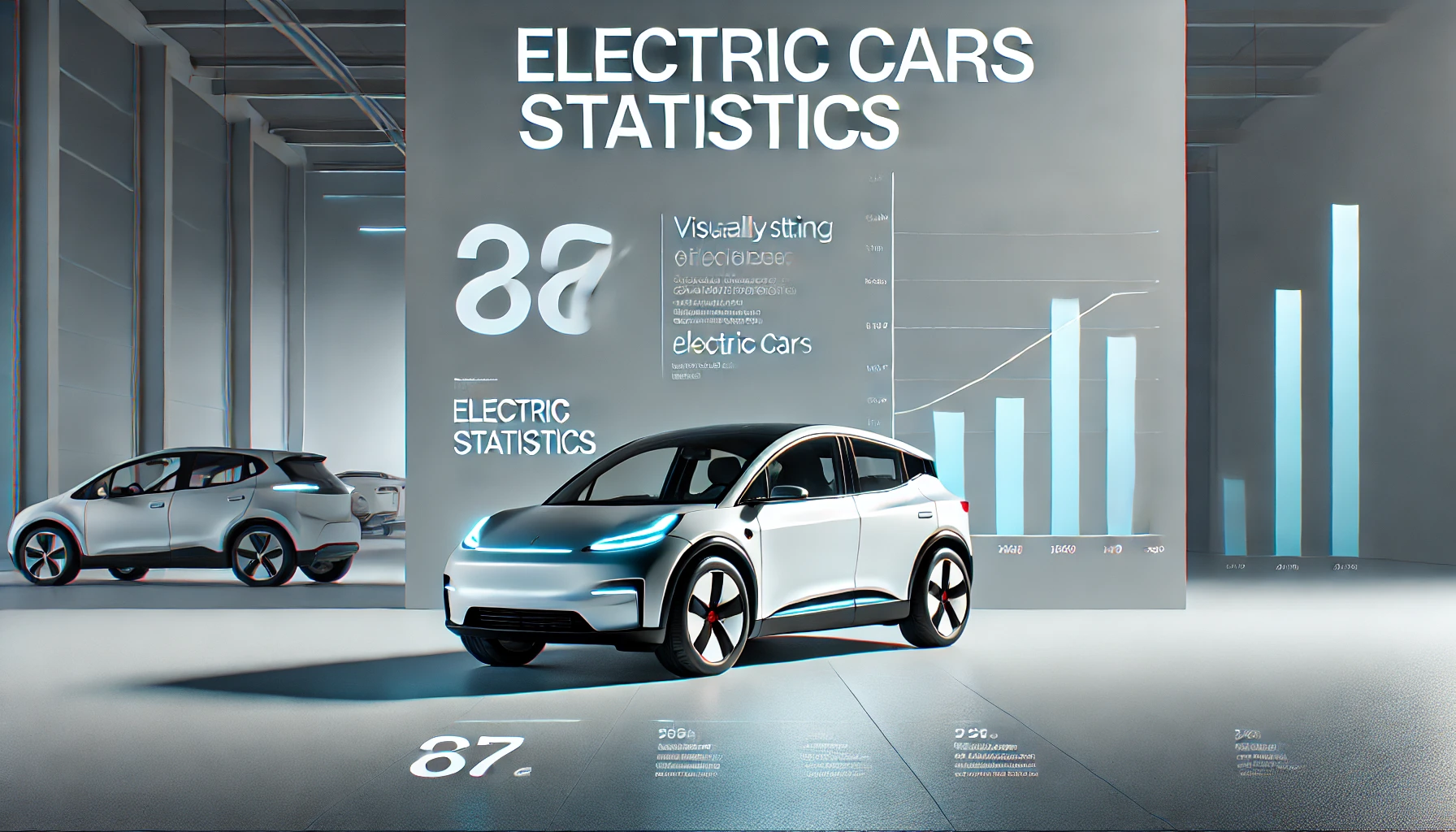Electric Cars Statistics By Automotive Manufacturer, Users, Sales, Market Share And Revenue
Updated · Oct 03, 2024

Table of Contents
- Introduction
- Editor’s Choice
- Electric Vehicle Users By Type
- Plug ElectricVehicle Sales Worldwide
- Plug-in Electric Vehicle Market Share By Vehicles
- Oil Displacement Due to Electric Vehicles
- Distribution of The Global Motor Market With Countries And Their Supportive Policies
- Global EV Financial Subsidies Among Countries
- Global Spending on Electric Vehicles
- Global Revenue For Electric Vehicles
- Global Electric Vehicles By Fleet Size
- List of Produced Electric Vehicles
- Global Electric Vehicles By Automotive Manufacturer
- Consumer Preference for Power Train
- Electric Cars Overview
- Conclusion
Introduction
Electric Cars Statistics: Electric vehicles are passenger automobile vehicles. That work uses electrical energy, which is its primary source of propulsion. Primarily, it focuses on plug-in electrical vehicles that utilize energy storage battery packs to convert electrical energy to mobile vehicles. It would be interesting to go through the Electric cars statistics and learn about exciting aspects based on these vehicles.
For the most part, they have as one of the most popular forms of transportation. As we go forward, we will learn how Electric vehicle sales have increased in recent years.
Editor’s Choice
- Battery electric vehicles reached 18,000k units by the end of 2022.
- Plug-in electric vehicle sales increased from 0.5 million in 2015 to 13.7 million by 2023.
- BYD leads the electric vehicle market with a 22% share.
- Oil displacement due to electric vehicles will reach 25,000 liters by 2022.
- Light-duty vehicles have a 97% share in the global electric vehicle market.
- Norway offers the highest EV subsidy at $20,360.
- Consumer spending on electric vehicles rose to $365 billion in 2022.
- Global electric vehicle revenue is expected to reach $1084 billion by 2029.
- The global electric vehicle fleet size is predicted to reach 77 million by 2025.
- BYD produced around 1.86 million electric vehicles worldwide in 2022.
- China leads in battery electric vehicle preference with 27% of consumers.
- Global electric car sales surpassed 10.5 million units in 2023, a 40% increase from 2022.
Electric Vehicle Users By Type

(Reference: statista.com)
- Electric car statistics showcase that Plug-in hybrid electric and battery electric are popular electric vehicles.
- By the end of 2022, the battery electric segment had 18,000k units, whereas plug-in hybrid electric vehicles had 7,900k units.
Plug ElectricVehicle Sales Worldwide

(Reference: statista.com)
- Electric car statistics showcase the consistent rise in sales of electric light vehicles.
- While in 2015, the sales of plug-in electric vehicles were 0.5 million, it has increased to 13.7 million by the end of 2023.

(Reference: statista.com)
- Electric car statistics showcase that BYD, Tesla Inc., VW Group, Geely-Volvo Car Group, and SAIC are top electric vehicles.
- BYD has the highest market share with 22%, followed by Tesla Inc. with 13.2% market share, VW Group with 7.3% market share, Geely-Volvo Car Group with 6.8% market share, SAIC with 5.8% market share and remaining small players have 45% market share.
Oil Displacement Due to Electric Vehicles

(Reference: statista.com)
- Electric Cars Statistics show that oil displacement due to electric vehicles has increased constantly.
- By the end of 2022, the oil displacement was 25,000 liters, significantly improving from over 150 million in 2011.
Distribution of The Global Motor Market With Countries And Their Supportive Policies
(Reference: statista.com)
- Electric Cars Statistics showcase that Light-duty vehicles, Electric vehicle supply equipment, Heavy-duty vehicles, and Two- and three-wheelers are the different categories of electric vehicles.
- Light duty vehicles have a 97% share with Asia, with 41% market share; Europe, with 29% market share; the Americas, with 24% market share; and the rest of the world, with a 3% market share.
- Electric vehicle supply equipment has a 71% share, with Asia with a 40% market share, Europe with a 26% market share, Americas with a 2% market share, the Rest of the world with a 2% market share, and Africa with a 1% market share.
- Heavy-duty vehicles comprise 58% of policy coverage, with Asia with a 31% market share, the Americas with a 16% market share, Europe with a 9% market share, and the Rest of the world with a 2% market share.
- Finally, two- and three-wheelers have accumulated a 29% market share, with Asia having a 28% market share and Europe having a 1% share.
Global EV Financial Subsidies Among Countries

(Reference: statista.com)
- Electric car statistics reveal that the governments of Norway, Singapore, the United States, Germany, Japan, Thailand, India, China, Brazil, Mexico, and the United Kingdom offer subsidies to promote electric vehicle usage.
- Norway has the highest amount of subsidiaries, with $20,360, followed by Singapore with $11,533, the United States with $7,500, Germany with $5,517, Japan with $4,803, Thailand with $3,655, India with $1,953, China with $1,157, Brazil with $725, Mexico with $674, United Kingdom with $660 average subsidy.
Global Spending on Electric Vehicles

(Reference: statista.com)
- Electric Cars Statistics show that consumer and government spending on electric vehicles has substantially increased.
- While in 2017, consumer spending was $39 billion, and government spending was $10 billion, it has increased to $365 billion, and government spending is $45 billion.
Global Revenue For Electric Vehicles

(Reference: statista.com)
- Electric Cars Statistics show that global electric vehicle revenue has increased over time.
- While 2016 the revenue was $44.39 billion, it has significantly increased to $770 billion by the end of 2023.
- By the end of 2029, the global electric vehicle will have a revenue of $1084 billion.
Global Electric Vehicles By Fleet Size

(Reference: statista.com)
- Electric Cars Statistics reveal that the project size of electric vehicles fleet has been increasing over time.
- In 2022, the global electric fleet size was 20 million units; by the end of 2025, it is predicted that the fleet will be 77 million.
List of Produced Electric Vehicles

(Source: wikipedia.com)
Global Electric Vehicles By Automotive Manufacturer

(Reference: statista.com)
- Electric cars statistics reveal Tesla, Geely Auto Group, Volvo Cars, BMW Group, GAC Group, Mercedes-Benz Group, SAIC Motor Corp., Changan Auto Co., Renault-Nissan-Mitsubishi Alliance, Hyundai Motors**, Chery Auto Co., Stellantis, Volkswagen Group, GM*, BYD are top electric vehicles.
- BYD is the top electric vehicle by production, with 1,858,364 vehicles, Tesla with 1,314,319 vehicles, Volkswagen Group with 839,207 vehicles, GM* with 584,602 vehicles, Stellantis with 512,276 vehicles, Hyundai Motors** with 497,816 vehicles, BMW Group with 433,164 vehicles, Geely Auto Group with 351,356 vehicles, Mercedes-Benz Group with 337,364 vehicles, Renault-Nissan-Mitsubishi Alliance with 335,964 vehicles, GAC Group with 287,977 vehicles, SAIC Motor Corp. with 256,341 vehicles, Volvo Cars with 253,266 vehicles, Chery Auto Co. with 253,141 vehicles, Changan Auto Co. with 245,555 vehicles, Others brands with 1,927,211 vehicles.
Consumer Preference for Power Train
(Reference: statista.com)
- Electric car statistics showcase that Battery electric (BEV), Other Gasoline or diesel (ICE), Plug-in hybrid electric (PHEV), and Hybrid electric (HEV) are the customer powertrain preferences.
- For Gasoline or diesel, the United States has the highest preference with 62%, India with 53%, Germany with 51%, China with 45%, South Korea with 38%, and Japan with 36%.
- Japan has the highest share of hybrid electric vehicles at 36%, followed by South Korea at 27%, the United States at 20%, India at 20%, Germany at 15%, and China at 14%.
- For battery electric vehicles, China is a leader with 27%, South Korea with 17%, Germany with 16%, Japan with 13%, the United States with 8%, and India with 8%.
- Regarding Plug-in Hybrid Electric (PHEV), Japan is a leader with 12%, India with 12%, South Korea with 13%, Germany with 12%, China with 10%, and the United States with 8%.
- For Other categories, India is a leader with 6%, followed by Germany with 6%, South Korea with 5%, United States with 4%, Japan with 2%, and China with 2%.
Electric Cars Overview
- Electric car statistics have grown significantly in recent years, reflecting the increasing demand for eco-friendly transportation solutions. As of 2023, global sales of electric cars have surpassed 10.5 million units, marking a 40% increase compared to 2022. This growth is primarily driven by the need to reduce carbon emissions and government incentives in various countries, such as tax rebates and subsidies.
- In terms of market value, the global electric car market is estimated to reach around 450 billion US dollars in 2023, with projections suggesting that it could exceed 800 billion US dollars by 2028. This highlights the increasing consumer preference for electric vehicles (EVs) over traditional gasoline-powered cars. Electric cars are cost-effective in the long run due to lower fuel and maintenance costs and offer technological advancements like autonomous driving and enhanced connectivity.
- China is leading the electric car market, accounting for over 60% of global sales in 2023. Europe follows with about 25%, while the United States represents approximately 10% of the market. These regions have invested considerably in electric vehicle infrastructure, such as charging stations, to support the growing demand. The European market, in particular, saw a 30% rise in sales in 2023, driven by stricter emission regulations.
- The price of electric cars has become more affordable. The average cost of electric vehicles in 2023 is about 48,000 US dollars, a decrease from previous years. With advancements in battery technology, electric vehicle ranges have also improved, with many cars offering over 300 miles on a single charge. By 2024, the number of electric vehicles sold is expected to reach 14 million units, further pushing the market forward.
- Electric Cars Statistics also indicate that electric vehicle adoption is increasing in emerging markets like India and Southeast Asia, where governments are setting ambitious targets for electric mobility by 2030. With increasing public and private investment, the electric vehicle market is expected to continue its upward trend.
- In conclusion, Electric car statistics show that the global shift toward electric vehicles is not just a trend but a long-term movement toward a sustainable future.
Conclusion
Electric cars have experienced remarkable growth in recent years, driven by environmental concerns, technological advancements, and supportive government policies. Electric car statistics reveal that China leads the market, accounting for over 60% of global sales, followed by Europe and the United States.
The increasing affordability of electric vehicles, with an average cost of $48,000 in 2023 and improved battery technology and range capabilities, has contributed to their wider adoption. As the world moves towards a more sustainable future, electric cars are poised to play a pivotal role in reducing carbon emissions and reshaping the automotive industry.
Sources
FAQ.
Battery electric vehicles (BEV) and plug-in hybrid electric vehicles (PHEV) are the main types.
BYD leads with a 22% market share, followed by Tesla Inc. with 13.2%.
It increased from over 150 million liters in 2011 to 25,000 by 2022.
Norway offers the highest subsidy at $20,360.
It increased from $39 billion in 2017 to $365 billion in 2022.
The global electric vehicle fleet is predicted to reach 77 million by 2025.
China leads, accounting for over 60% of global sales in 2023.
The average cost is about $48,000, which has decreased from previous years.
By 2024, the number of electric vehicles sold will reach 14 million units.

Saisuman is a skilled content writer with a passion for mobile technology, law, and science. She creates featured articles for websites and newsletters and conducts thorough research for medical professionals and researchers. Fluent in five languages, Saisuman's love for reading and languages sparked her writing career. She holds a Master's degree in Business Administration with a focus on Human Resources and has experience working in a Human Resources firm. Saisuman has also worked with a French international company. In her spare time, she enjoys traveling and singing classical songs. Now at Smartphone Thoughts, Saisuman specializes in reviewing smartphones and analyzing app statistics, making complex information easy to understand for readers.










